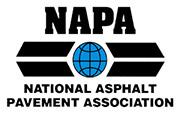New Paving & Tire Scuffing
New Paving & Tire Scuffing
 Scuff marks on newly built asphalt pavement commonly appear once traffic is given access. In virtually all cases, these tire scuffs will vanish when traffic increases and will leave no trace behind. Scuff marks are rarely an indication of improper construction or a reduced life for the pavement. Since these marks are superficial and strictly an aesthetic issue, it is usually best to leave them alone; attempts to remove them often damage the surface of the pavement.
Scuff marks on newly built asphalt pavement commonly appear once traffic is given access. In virtually all cases, these tire scuffs will vanish when traffic increases and will leave no trace behind. Scuff marks are rarely an indication of improper construction or a reduced life for the pavement. Since these marks are superficial and strictly an aesthetic issue, it is usually best to leave them alone; attempts to remove them often damage the surface of the pavement.
New Paving & Tire Scuffing – Common Causes of Scuff Marks
Tire scuffing can be caused by several different circumstances. Some of these factors can be controlled or mitigated by the property owner, but most tire scuffs will be difficult or impossible to avoid.
• Pavement was given inadequate time to cure. It is often possible to open a newly installed pavement just hours after it is completed. However, allowing the pavement longer to cure before permitting traffic to access the pavement helps make the pavement more resistant to tire scuffing.
• Power steering is engaged while the car is motionless. A leading cause of tire scuffing is drivers who turn their wheels while the vehicle is idling. Vehicles equipped with front-wheel drive are especially likely to scuff the pavement if the front wheels of a stationary vehicle are turned.
• If a parking lot or other asphalt pavement is near a highway, vehicles that have been driving on the highway may arrive with hot tires. The heat from their tires can make tire scuffing more probable, especially during the summer months.
• Scuffing is more likely to occur if the pavement is installed when the weather is humid and hot. Tire scuffs are also more common during the pavement’s first summer even if the pavement was installed in the spring.
• Low-profile tires are relatively new, but they are becoming increasingly common. These tires feature a lower sidewall-to-tread aspect ratio and typically require greater tire pressure than traditional designs. As a result, low-profile tires exert more stress on the pavement, making tire scuffs more likely to occur.
• The asphalt mix design can be a factor in how well the pavement resists scuffing. If appearance is of primary importance, the mix will have smaller aggregates to provide a tighter, smoother surface that is visually appealing — and more prone to tire scuffing. Mixes with coarser aggregates may be less aesthetic, but they are less likely to scuff.
• Although it is highly unlikely, construction issues could cause or contribute to tire scuffing. If the pavement is not compacted properly, this may contribute to scuffing. If the contractor does not ensure that his equipment does not encroach on a newly built, uncured pavement, the equipment can leave scuff marks and/or indentations behind.
If you are worried that the tire scuffs on your new pavement are more than superficial, contact the Cape Cod paving professionals at Dirtworks. We are a local, family owned, highly regarded asphalt paving company serving customers throughout the Cape Cod region for more than two decades. Our services include asphalt paving, milling, parking lot striping, asphalt repairs, line striping, sealcoating, snow removal and site work. We also offer a full line of excavation services and are insured and fully licensed for demolition. Our exemplary reputation has been built on our high-quality work and outstanding customer service. If you have more questions about New Paving & Tire Scuffing or would like to receive a free estimate, call us at (508) 240-5541 or fill out our convenient online form.
See Recent FAQs Below






